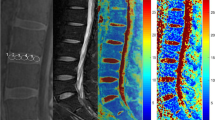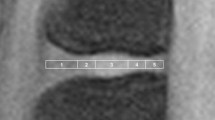Abstract
Objectives
To demonstrate the potential benefits of biochemical axial T2* mapping of intervertebral discs (IVDs) regarding the detection and grading of early stages of degenerative disc disease using 1.5-Tesla magnetic resonance imaging (MRI) in a clinical setting.
Methods
Ninety-three patients suffering from lumbar spine problems were examined using standard MRI protocols including an axial T2* mapping protocol. All discs were classified morphologically and grouped as “healthy” or “abnormal”. Differences between groups were analysed regarding to the specific T2* pattern at different regions of interest (ROIs).
Results
Healthy intervertebral discs revealed a distinct cross-sectional T2* value profile: T2* values were significantly lower in the annulus fibrosus compared with the nucleus pulposus (P = 0.01). In abnormal IVDs, T2* values were significantly lower, especially towards the centre of the disc representing the expected decreased water content of the nucleus (P = 0.01). In herniated discs, ROIs within the nucleus pulposus and ROIs covering the annulus fibrosus showed decreased T2* values.
Conclusions
Axial T2* mapping is effective to detect early stages of degenerative disc disease. There is a potential benefit of axial T2* mapping as a diagnostic tool, allowing the quantitative assessment of intervertebral disc degeneration.
Key Points
• Axial T2* mapping effective in detecting early degenerative disc disease.
• Healthy and abnormal intervertebral discs revealed distinct cross-sectional T2* value profiles.
• T2* can be performed at 1.5 T in a clinical setting.






Similar content being viewed by others
References
Andersson GB (1998) Epidemiology of low back pain. Acta Orthop Scand Suppl 281:28–31
Podichetty VK (2007) The aging spine: the role of inflammatory mediators in intervertebral disc degeneration. Cell Mol Biol (Noisy-le-grand) 53:4–18
Boos N, Wallin A, Gbedegbegnon T, Aebi M, Boesch C (1993) Quantitative MR imaging of lumbar intervertebral disks and vertebral bodies: influence of diurnal water content variations. Radiology 188:351–354
Buckwalter JA (1995) Aging and degeneration of the human intervertebral disc. Spine (Phila Pa 1976) 20:1307–1314
Paajanen H, Lehto I, Alanen A, Erkintalo M, Komu M (1994) Diurnal fluid changes of lumbar discs measured indirectly by magnetic resonance imaging. J Orthop Res 12:509–514. doi:10.1002/jor.1100120407
Roberts N, Hogg D, Whitehouse GH, Dangerfield P (1998) Quantitative analysis of diurnal variation in volume and water content of lumbar intervertebral discs. Clin Anat 11:1–8. doi:10.1002/(SICI)1098-2353(1998)
Pfirrmann CW, Metzdorf A, Zanetti M, Hodler J, Boos N (2001) Magnetic resonance classification of lumbar intervertebral disc degeneration. Spine (Phila Pa 1976) 26:1873–1878
Schiebler ML, Camerino VJ, Fallon MD, Zlatkin MB, Grenier N, Kressel HY (1991) In vivo and ex vivo magnetic resonance imaging evaluation of early disc degeneration with histopathologic correlation. Spine 16:635–640
Gunzburg R, Parkinson R, Moore R et al (1992) A cadaveric study comparing discography, magnetic resonance imaging, histology, and mechanical behavior of the human lumbar disc. Spine 17:417–426
Benneker LM, Heini PF, Anderson SE, Alini M, Ito K (2005) Correlation of radiographic and MRI parameters to morphological and biochemical assessment of intervertebral disc degeneration. Eur Spine J 14:27–35
Antoniou J, Steffen T, Nelson F et al (1996) The human lumbar intervertebral disc: evidence for changes in the biosynthesis and denaturation of the extracellular matrix with growth, maturation, ageing, and degeneration. J Clin Invest 98:996–1003. doi:10.1172/JCI118884
Thompson JP, Pearce RH, Schechter MT, Adams ME, Tsang IK, Bishop PB (1990) Preliminary evaluation of a scheme for grading the gross morphology of the human intervertebral disc. Spine (Phila Pa 1976) 15:411–415
Watanabe A, Benneker LM, Boesch C, Watanabe T, Obata T, Anderson SE (2007) Classification of intervertebral disk degeneration with axial T2 mapping. AJR Am J Roentgenol 189:936–942. doi:10.2214/AJR.07.2142
Murphy BJ (2001) Evaluation of grades 3 and 4 chondromalacia of the knee using T2*-weighted 3D gradient-echo articular cartilage imaging. Skeletal Radiol 30:305–311
Krause FG, Klammer G, Benneker LM, Werlen S, Mamisch TC, Weber M (2010) Biochemical T2* MR quantification of ankle arthrosis in pes cavovarus. J Orthop Res 28:1562–1568. doi:10.1002/jor.21192
Pfirrmann CW, Metzdorf A, Zanetti M, Hodler J, Boos N (2001) Magnetic resonance classification of lumbar intervertebral disc degeneration. Spine 26:1873–1878
Trattnig S, Stelzeneder D, Goed S et al (2010) Lumbar intervertebral disc abnormalities: comparison of quantitative T2 mapping with conventional MR at 3.0 T. Eur Radiol 20:2715–2722. doi:10.1007/s00330-010-1843-2
Stelzeneder D, Welsch GH, Kovacs BK et al (2011) Quantitative T2 evaluation at 3.0 T compared to morphological grading of the lumbar intervertebral disc: a standardized evaluation approach in patients with low back pain. Eur J Radiol 81:324–330. doi:10.1016/j.ejrad.2010.12.093
Welsch GH, Trattnig S, Paternostro-Sluga T et al (2010) Parametric T2 and T2* mapping techniques to visualize intervertebral disc degeneration in patients with low back pain: initial results on the clinical use of 3.0 Tesla MRI. Skeletal Radiol 40:543–551. doi:10.1007/s00256-010-1036-8
Xia Y (2000) Magic-angle effect in magnetic resonance imaging of articular cartilage: a review. Invest Radiol 35:602–621
Hardy PA (1996) Intervertebral disks on MR images: variation in signal intensity with the disk-to-magnetic field orientation. Radiology 200:143–147
Acknowledgements
This study was supported by the ‘Stipendienfonds’ of the Swiss Orthopaedic Association (SGO).
Author information
Authors and Affiliations
Corresponding author
Rights and permissions
About this article
Cite this article
Hoppe, S., Quirbach, S., Mamisch, T.C. et al. Axial T2* mapping in intervertebral discs: a new technique for assessment of intervertebral disc degeneration. Eur Radiol 22, 2013–2019 (2012). https://doi.org/10.1007/s00330-012-2448-8
Received:
Revised:
Accepted:
Published:
Issue Date:
DOI: https://doi.org/10.1007/s00330-012-2448-8




